A Method for Assessing the Feasibility of Integrating Planned Unidirectional EV Chargers into the Distribution Grid: A Case Study in Danang, Vietnam
Abstract
1. Introduction
- Peak load: Although the power demand will not significantly increase as a result of integrating EV chargers into the distribution grid, the load curve will probably change. As people charge their EVs when they get home from work, the evening peak loads will most noticeably rise. The peak loads will significantly increase around these residential hotspots and other EV charging concentration points, such as public EV fast-charging stations and commercial vehicle depots. According to the analysis, the local peak load in an area with a 25% EV penetration would rise by about 30% [9].
- Voltage stability: The installation of EV chargers will result in a significant increase in a system’s load curve; the higher peak time demand may have an undesirable influence on the network’s voltage stability [10,11]. This component of distribution networks is crucial to their safety. As a result, this component must be considered during the planning stage to avoid any unexpected faults.
- Transformer life: The load demand grows as more charging stations are connected to the distribution transformer’s secondary side. The increase of the peak load at the transformers will lead to the transformer being overloaded during peak hours [14,15]. In this case, the electric utilities should have a plan to replace or upgrade the transformers accordingly.
- -
- Investigate grid operation requirements to integrate planned EV chargers into the distribution grid in Vietnam.
- -
- Propose a two-level evaluation method for assessing the feasibility of integrating the planned EV chargers into the distribution network.
- -
- Evaluate the feasibility of integrating EV chargers into Danang’s distribution grid based on the number of planned EV chargers in the area.
2. EV Charger Specifications and Operation Standards for Distribution Grid in Vietnam
2.1. EV Charger Specifications
- -
- Charger level 1: These chargers are usually installed in residential areas. Level 1 chargers operate at 120 V (AC) and have a current rating of 15 A or 20 A. This type of charger takes between 8 and 16 h to fully charge an electric vehicle with a battery capacity of 20 kWh. The advantages of the chargers are that they are less expensive and require no additional charging equipment.
- -
- Charger level 2: They are usually located in residential and commercial areas. Level 2 chargers require a voltage source of 240 V (AC) with rated current up to 40 A in residential areas. Public charging stations require 400 V three-phase AC with up to 80 A current handling capacity. Level 2 chargers need about 4 to 8 h to fully charge a 20 kWh electric vehicle battery. This charging station has a rated capacity from 5.2 to 25.6 kW.
- -
- Charger level 3—Direct current fast charger: This type of charger, which is the most efficient and fastest type of electric vehicle charging, is commonly located in commercial and public areas. This charging station can charge up to 80% of the battery capacity in only 10–15 min. Level 3 chargers require a three-phase 480 V or greater circuit.
2.2. Distribution Grid Operation Requirements for Integrating New EV Charger Load in Vietnam
- High-level integration requirements
- -
- Power frequency
- +
- In the normal operation mode 49.8 Hz ≤ f ≤ 50.2 Hz;
- +
- In the unstable operation mode: 49.5 Hz ≤ f ≤ 50.5 Hz
- -
- Voltage supply
- +
- In the normal operation mode:
- ▪
- At the customer’s connection point: V − 5% ≤ ΔV ≤ V + 5%;
- ▪
- At the power plant’s connection point: V − 5% ≤ ΔV ≤ V + 10%;
- +
- In the single fault or post-fault service restoration mode:
- +
- In the serious fault mode of the electrical transmission system:
- -
- Power losses
- Low-level integration requirements
- -
- Voltage unbalance
- -
- Harmonics
- -
- Flicker severity
- ▪
- The 95% short-term flicker (Pst95%) at the medium and low voltage measured for 10 min with standardized measurement equipment should not exceed 0.9.
- ▪
- The long-term flicker (Plt95%) calculated from 12 continuous measurement results of Pst should not exceed 0.7.
3. Assessment Methodology for Integrating Planned Unidirectional EV Chargers into the Distribution Grid in Vietnam
- -
- Collect inputs: This step involves gathering data about the distribution grid, including the feeder configuration, load profiles, and pre-planned locations for EV chargers. This is one of the most important steps: the more detailed information of the grid can be collected, the higher accuracy can be achieved through the assessment process.
- -
- Simulation process: Simulations are implemented using PSS/ADEPT software to analyze the performance of the distribution grid with and without EV chargers. There are two scenarios that were considered:
- +
- Scenario 1: In this scenario, the aggregated information is validated, and the current distribution system is simulated. Then, the power analysis is done on a snapshot during peak hour of a typical day. This helps establish a baseline for the distribution grid’s performance.
- +
- Scenario 2: In this scenario, pre-planned EV chargers are added to the considered distribution power system. The power analysis is then run again on a snapshot during the peak hour of a typical day to determine how the added loads and EV chargers affect the distribution grid’s performance.
- -
- Evaluation process: This step evaluates the simulation results and determines the feasibility of integrating EV chargers into the feeders. The following tasks are carried out:
- +
- Results recording: The simulation results are recorded, including bus voltages, branches, power losses, etc.
- +
- Check distribution grid operation requirements: The results are checked to ensure that they meet the voltage limitations and power loss requirements of the distribution grid.
- +
- Evaluate feasibility: The simulation results are evaluated to determine the feasibility of integrating EV chargers into the feeders. This includes determining whether the addition of EV chargers will cause any problems with the grid’s performance and identifying any necessary changes that must be made to the distribution grid to accommodate the additional EV chargers.
4. Applications on Danang’s Distribution Grid
- -
- Encouraging public procurement and use of electric cars in departments and state agencies in Danang based on compliance with the provisions of the law [40];
- -
- Creating a roadmap to convert petrol-based public buses to electric buses [41];
- -
- Proposing a lower interest rate to support projects that produce or use clean technology, clean energy, and renewable energy to subsidize interest rates on charging station loans [42].
- -
- For government areas: encouraging investment under the public–private partnership (PPP) mechanism or other incentive policies to promote and support the investment in charging stations at public offices.
5. Results and Discussion
- -
- Scenario 1: Assessing the current distribution grid’s operation.
- -
- Scenario 2.1: Assessing the distribution grid’s operation for the time period of 2020–2025.
- +
- Case 2.1.1: Assessing the distribution grid’s operation with a 10% increase in normal load compared to the current distribution grid for 2025.
- +
- Case 2.1.2: Assessing the distribution grid’s operation with a 10% increase in normal load compared to the current distribution grid and the addition of level 1 and 2 chargers to the distribution grid for 2025.
- +
- Case 2.1.3: Assessing the distribution grid’s operation with a 10% increase in normal load compared to the current distribution grid and the addition of level 1 and 2 chargers, as well as predefined fast chargers, to the distribution grid for 2025.
- -
- Scenario 2.2: Assessing the distribution grid’s operation for 2030.
- +
- Case 2.2.1: Assessing the distribution grid’s operation with a 10% increase in normal load compared to the 2025 distribution grid for 2030.
- +
- Case 2.2.2: Assessing the distribution grid’s operation with a 10% increase in normal load compared to the 2025 distribution grid and the addition of level 1 and 2 chargers to the distribution grid for 2030.
- +
- Case 2.2.3: Assessing the distribution grid’s operation with a 10% increase in normal load compared to the 2025 distribution grid and the addition of level 1 and 2 chargers, as well as predefined fast chargers, to the distribution grid for 2030.
- -
- Feeder 472: This 22 kV feeder is responsible for delivering electricity to a network of 57 buses. The total current load on the feeder is 2.56 MW. To meet the growing demand for electric vehicles, there are plans to integrate four fast chargers into the feeder. A total of 3 250 kVA fast chargers will be installed at buses 27, 28, and 35 in 2025. In addition to these 3 fast chargers, there is a plan to install 1 more 250 kVA fast charger at bus 15 in 2030. This charger will be strategically located to provide electric vehicle drivers with a convenient and reliable charging option, helping to promote the adoption of electric vehicles in the area. The feeder single line with predefined location of fast chargers in 2025 and 2030 is shown in Figure 6 below. The simulation results for seven cases of two scenarios are shown in Table 6.
- -
- Feeder 474: This 22 kV feeder is responsible for delivering electricity to a network of 36 buses. The total current load on the feeder is 2.43 MW. Just as with feeder 472, there are 4 fast chargers going to be integrated into the feeder 474. Two 250 kVA fast chargers are going to be integrated at buses three and four in 2025. A total of 2 more will be integrated at buses 29 and 30 in 2030. The capacities of integrated chargers of levels one and two are 160 kVA and 330 kVA by 2025 and 2030, respectively. The feeder single line with predefined location of fast chargers in 2025 and 2030 is shown in Figure 7 below. The simulation results for seven cases of two scenarios are shown in Table 7.
6. Conclusions
Author Contributions
Funding
Data Availability Statement
Conflicts of Interest
References
- Cao, J.; Chen, X.; Qiu, R.; Hou, S. Electric vehicle industry sustainable development with a stakeholder engagement system. Technol. Soc. 2021, 67, 101771. [Google Scholar] [CrossRef]
- Hill, G.; Heidrich, O.; Creutzig, F.; Blythe, P. The role of electric vehicles in near-term mitigation pathways and achieving the UK’s carbon budget. Appl. Energy 2019, 251, 113111. [Google Scholar] [CrossRef]
- Tran, Q.T.; Roose, L.; Vichitpunt, C.; Thongmai, K.; Noisopa, K. A Comprehensive Model to Estimate Electric Vehicle Battery State of Charge for a Pre-Scheduled Trip Based on Energy Consumption Estimation. Clean Technol. 2023, 5, 25–37. [Google Scholar] [CrossRef]
- D’Adamo, I.; Rosa, P. A Structured Literature Review on Obsolete Electric Vehicles Management Practices. Sustainability 2019, 11, 6876. [Google Scholar] [CrossRef]
- International Energy Agency (IEA). Global EV Data Explorer. Available online: https://www.iea.org/data-and-statistics/data-tools/global-ev-data-explorer (accessed on 1 December 2022).
- Dubey, A.; Santoso, S. Electric Vehicle Charging on Residential Distribution Systems: Impacts and Mitigations. IEEE Access 2015, 3, 1871–1893. [Google Scholar] [CrossRef]
- Warweg, O.; Schaller, F.; Ritter, S.; Bretschneider, P. Technical and regulatory challenges for the integration of electric vehicles into the energy system. In Proceedings of the 2011 2nd IEEE PES International Conference and Exhibition on Innovative Smart Grid Technologies, Manchester, UK, 5–7 December 2011; pp. 1–8. [Google Scholar]
- Gong, Q.; Midlam-Mohler, S.; Marano, V.; Rizzoni, G. Study of PEV Charging on Residential Distribution Transformer Life. IEEE Trans. Smart Grid 2012, 3, 404–412. [Google Scholar] [CrossRef]
- Engel, R.H.H.; Knupfer, S.; Sahdev, S. The Potential Impact of Electric Vehicles on Global Energy Systems. Available online: https://www.mckinsey.com/industries/automotive-and-assembly/our-insights/the-potential-impact-of-electric-vehicles-on-global-energy-systems (accessed on 2 January 2023).
- Sai, N.K.S.P.V.; Shivkumar, V.; Krishnan, N.; Sharma, G.; Senjyu, T. Voltage stability analysis of distribution systems in presence of electric vehicle charging stations with coordinated charging scheme. Int. Trans. Electr. Energy Syst. 2021, 31, e13248. [Google Scholar]
- Tavakoli, A.; Saha, S.; Arif, M.T.; Haque, M.E.; Mendis, N.; Oo, A.M.T. Impacts of grid integration of solar PV and electric vehicle on grid stability, power quality and energy economics: A review. IET Energy Syst. Integr. 2020, 2, 243–260. [Google Scholar] [CrossRef]
- Gomez, J.C.; Morcos, M.M. Impact of EV battery chargers on the power quality of distribution systems. IEEE Trans. Power Deliv. 2003, 18, 975–981. [Google Scholar] [CrossRef]
- Sivaraman, P.; Raj, J.S.S.S.; Kumar, P.A. Power quality impact of electric vehicle charging station on utility grid. In Proceedings of the 2021 IEEE Madras Section Conference (MASCON), Chennai, India, 27–28 August 2021; pp. 1–4. [Google Scholar]
- Smith, T.; Garcia, J.; Washington, G. Novel PEV Charging Approaches for Extending Transformer Life. Energies 2022, 15, 4454. [Google Scholar] [CrossRef]
- Kuspan, B.; Bagheri, M.; Abedinia, O.; Naderi, M.S.; Jamshidpour, E. The Influence of Electric Vehicle Penetration on Distribution Transformer Ageing Rate and Performance. In Proceedings of the 2018 7th International Conference on Renewable Energy Research and Applications (ICRERA), Paris, France, 14–17 October 2018; pp. 313–318. [Google Scholar]
- Nutkani, I.U.; Lee, J.C. Evaluation of Electric Vehicles (EVs) Impact on Electric Grid. In Proceedings of the 2022 International Power Electronics Conference (IPEC-Himeji 2022-ECCE Asia), Himeji, Japan, 15–19 May 2022; pp. 239–246. [Google Scholar]
- Anastasiadis, A.G.; Kondylis, G.P.; Polyzakis, A.; Vokas, G. Effects of Increased Electric Vehicles into a Distribution Network. Energy Procedia 2019, 157, 586–593. [Google Scholar] [CrossRef]
- Klayklueng, T.; Dechanupaprittha, S. Impact analysis on voltage unbalance of EVs charging on a low voltage distribution system. In Proceedings of the 2014 International Electrical Engineering Congress (iEECON), Pattaya City, Thailand, 19–21 March 2014; pp. 1–4. [Google Scholar]
- Spitzer, M.; Schlund, J.; Apostolaki-Iosifidou, E.; Pruckner, M. Optimized Integration of Electric Vehicles in Low Voltage Distribution Grids. Energies 2019, 12, 4059. [Google Scholar] [CrossRef]
- Ul-Haq, A.; Cecati, C.; Strunz, K.; Abbasi, E. Impact of Electric Vehicle Charging on Voltage Unbalance in an Urban Distribution Network. Intell. Ind. Syst. 2015, 1, 51–60. [Google Scholar] [CrossRef]
- Belonogova, N.; Honkapuro, S.; Partanen, J.; Simolin, T.; Rautiainen, A.; Heine, P.; Lepistö, N. Assessment of EV hosting capacity in a workplace environment in different charging strategies. In Proceedings of the CIRED 2020 Berlin Workshop (CIRED 2020), Berlin, Germany, 22–23 September 2020; Volume 2020, pp. 444–447. [Google Scholar]
- Fachrizal, R.; Ramadhani, U.H.; Munkhammar, J.; Widén, J. Combined PV–EV hosting capacity assessment for a residential LV distribution grid with smart EV charging and PV curtailment. Sustain. Energy Grids Netw. 2021, 26, 100445. [Google Scholar] [CrossRef]
- He, L.; He, J.; Zhu, L.; Huang, W.; Wang, Y.; Yu, H. Comprehensive evaluation of electric vehicle charging network under the coupling of traffic network and power grid. PLoS ONE 2022, 17, e0275231. [Google Scholar] [CrossRef] [PubMed]
- Karmaker, A.K.; Roy, S.; Ahmed, M.R. Analysis of the Impact of Electric Vehicle Charging Station on Power Quality Issues. In Proceedings of the 2019 International Conference on Electrical, Computer and Communication Engineering (ECCE), Coxs Bazar, Bangladesh, 7–9 February 2019; pp. 1–6. [Google Scholar]
- Zelic, J.; Novakovic, L.; Klindo, I.; Gruosso, G. Hardware in the loop Framework for analysis of Impact of Electrical Vehicle Charging Devices on Distribution network. In Proceedings of the 2020 IEEE Vehicle Power and Propulsion Conference (VPPC), Virtually, 18 November–16 December 2020; pp. 1–5. [Google Scholar]
- Deb, S.; Tammi, K.; Kalita, K.; Mahanta, P. Impact of Electric Vehicle Charging Station Load on Distribution Network. Energies 2018, 11, 178. [Google Scholar] [CrossRef]
- Yu, H.; Niu, S.; Shang, Y.; Shao, Z.; Jia, Y.; Jian, L. Electric vehicles integration and vehicle-to-grid operation in active distribution grids: A comprehensive review on power architectures, grid connection standards and typical applications. Renew. Sustain. Energy Rev. 2022, 168, 112812. [Google Scholar] [CrossRef]
- Zheng, Y.; Niu, S.; Shang, Y.; Shao, Z.; Jian, L. Integrating plug-in electric vehicles into power grids: A comprehensive review on power interaction mode, scheduling methodology and mathematical foundation. Renew. Sustain. Energy Rev. 2019, 112, 424–439. [Google Scholar] [CrossRef]
- Brenna, M.; Foiadelli, F.; Leone, C.; Longo, M. Electric Vehicles Charging Technology Review and Optimal Size Estimation. J. Electr. Eng. Technol. 2020, 15, 2539–2552. [Google Scholar] [CrossRef]
- Developing Electric Vehicles in Vietnam: The Problem of Infrastructure. Available online: https://sokhcn.langson.gov.vn/node/15170 (accessed on 2 January 2023).
- Ministry of Industry and Trade. Circular Stipulating the Electrical Distribution System. Available online: http://vepg.vn/wp-content/uploads/2020/07/39_2015_TT-BCT_296868_EN.pdf (accessed on 2 January 2023).
- Circular No. 30/2019/TT-BCT Amendments and Supplements to Several Articles of Circular No. 25/2016/TT-BCT and Circular No. 39/2015/TT-BCT on Electricity Distribution System. Available online: https://thuvienphapluat.vn/van-ban/Thuong-mai/Thong-tu-30-2019-TT-BCT-sua-doi-Thong-tu-25-2016-TT-BCT-39-2015-TT-BCT-he-thong-dien-phan-phoi-428704.aspx (accessed on 2 January 2023).
- Tran, Q.T.; Davies, K.; Sepasi, S. Isolation Microgrid Design for Remote Areas with the Integration of Renewable Energy: A Case Study of Con Dao Island in Vietnam. Clean Technol. 2021, 3, 804–820. [Google Scholar] [CrossRef]
- Sanseverino, E.R.; Tran, Q.T.T.; Van, B.D.; Le, H.T.T.; Quang, N.N. Challenges and Opportunities for Renewable-Based Microgrids Integration in Vietnam. In Innovations in Land, Water and Energy for Vietnam’s Sustainable Development; Anderle, M., Ed.; Springer International Publishing: Berlin/Heidelberg, Germany, 2021; pp. 109–127. [Google Scholar]
- Study of Electric Mobility Development in Viet Nam. Available online: https://changing-transport.org/publications/study-of-electric-mobility-development-in-viet-nam/ (accessed on 2 January 2023).
- Green Vehicles: The World “Leap forward” and the Situation in Vietnam. Available online: https://www.vietnamplus.vn/phuong-tien-xanh-the-gioi-nhay-vot-va-thuc-trang-tai-viet-nam/773596.vnp (accessed on 2 January 2023).
- Decision No 124/QD-UBND Dated 14/01/2021 on Approval of Proposal Project about Charging Stations Locations and Incentive Mechanism for EVs and Charging Stations in Da Nang City. 2021. Available online: https://thuvienphapluat.vn/van-ban/Giao-thong-Van-tai/Quyet-dinh-124-QD-UBND-2021-De-xuat-cac-vi-tri-xay-dung-tram-sac-o-to-dien-thanh-pho-Da-Nang-467978.aspx (accessed on 2 January 2023).
- Tran, V.C.M.; Le, H.S.; Matsui, Y. Current status and behavior modeling on household solid-waste separation: A case study in Da Nang city, Vietnam. J. Mater. Cycles Waste Manag. 2019, 21, 1462–1476. [Google Scholar] [CrossRef]
- Decree No.04/2019/NDCP Issued 11/01/2019 of the VietNam Government Stipulating Standards and Norms for Car Use and Decree No.34/2020/QD-UBND Issued 28/09/2020, of the People’s Committee of da Nang on Standards for Special-Use Cars at Agencies, Organizations, and Units under the Management of Da Nang Government. 2019. Available online: https://thuvienphapluat.vn/van-ban/Tai-chinh-nha-nuoc/Nghi-dinh-04-2019-ND-CP-quy-dinh-tieu-chuan-dinh-muc-su-dung-xe-o-to-404821.aspx (accessed on 2 January 2023).
- Decision No. 876/QD-TTg Dated July 22, 2022, Approving the Action Program on Green Energy Transformation, Reducing Carbon and Methane Emissions of the Transport Sector. Available online: https://thuvienphapluat.vn/van-ban/Giao-thong-Van-tai/Quyet-dinh-876-QD-TTg-2022-chuyen-doi-nang-luong-xanh-giam-khi-cac-bon-nganh-giao-thong-523057.aspx#:~:text=%C4%90%E1%BA%BFn%202030%2C%20100%25%20ph%C6%B0%C6%A1ng%20ti%E1%BB%87n,do%20Th%E1%BB%A7%20t%C6%B0%E1%BB%9Bng%20ban%20h%C3%A0nh (accessed on 2 January 2023).
- Resolution No.149/2018/NQ-HDND Dated July 12, 2018, of the People’s Council of Da Nang. Available online: https://thuvienphapluat.vn/van-ban/Dau-tu/Nghi-quyet-149-2018-NQ-HDND-ho-tro-lai-suat-doi-voi-cac-to-chuc-vay-von-de-dau-tu-Da-Nang-389614.aspx (accessed on 2 January 2023).
- Bui, T.M.T.; Le, H.L.; Le, N.K.; Phan, Q.T.; Nguyen, K.V.; Dang, N.H. Evaluating the impact of Khanh Son power plant on Danang Distribution Network. Int. J. Emerg. Electr. Power Syst. 2022, 23, 221–231. [Google Scholar] [CrossRef]
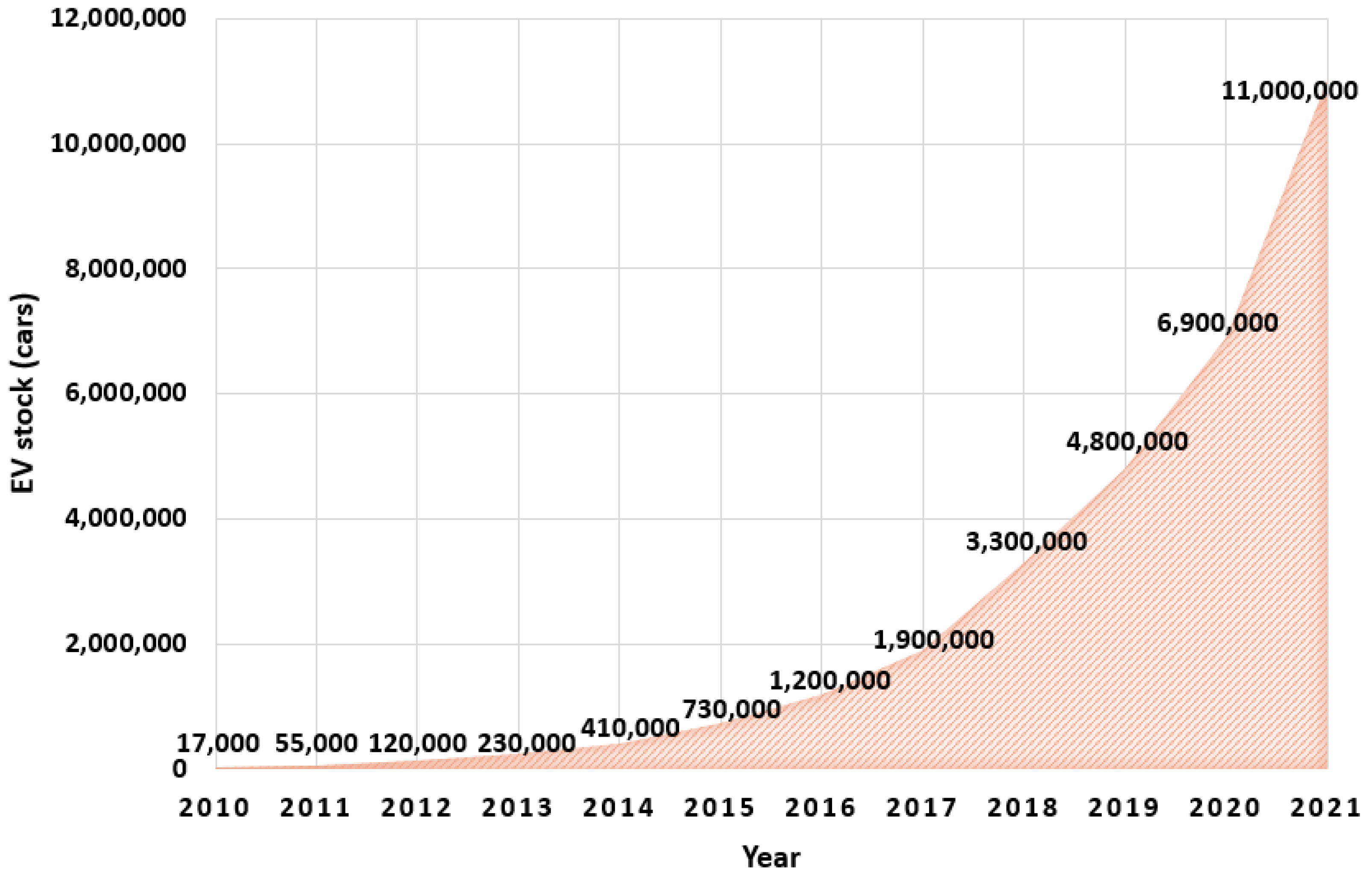

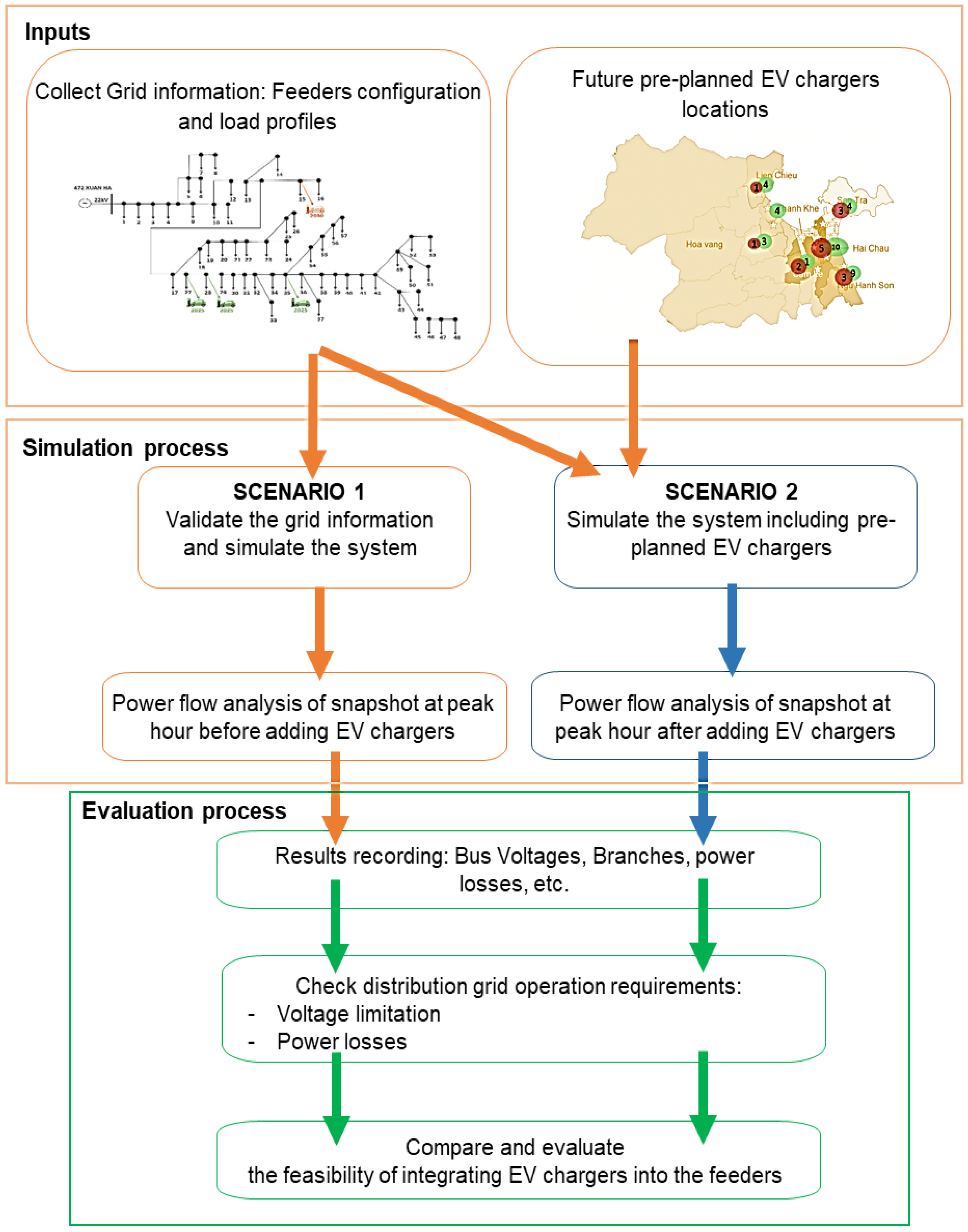

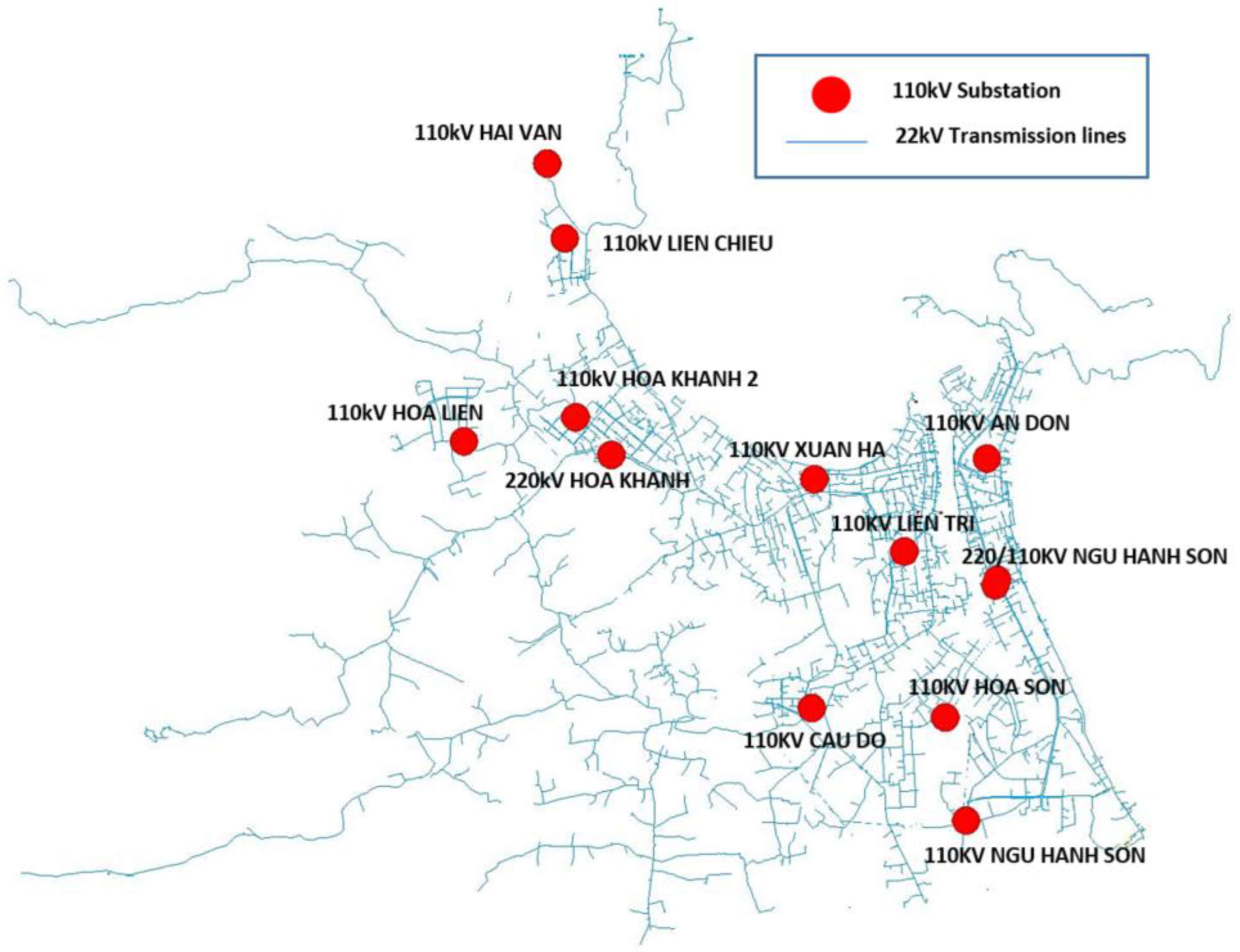
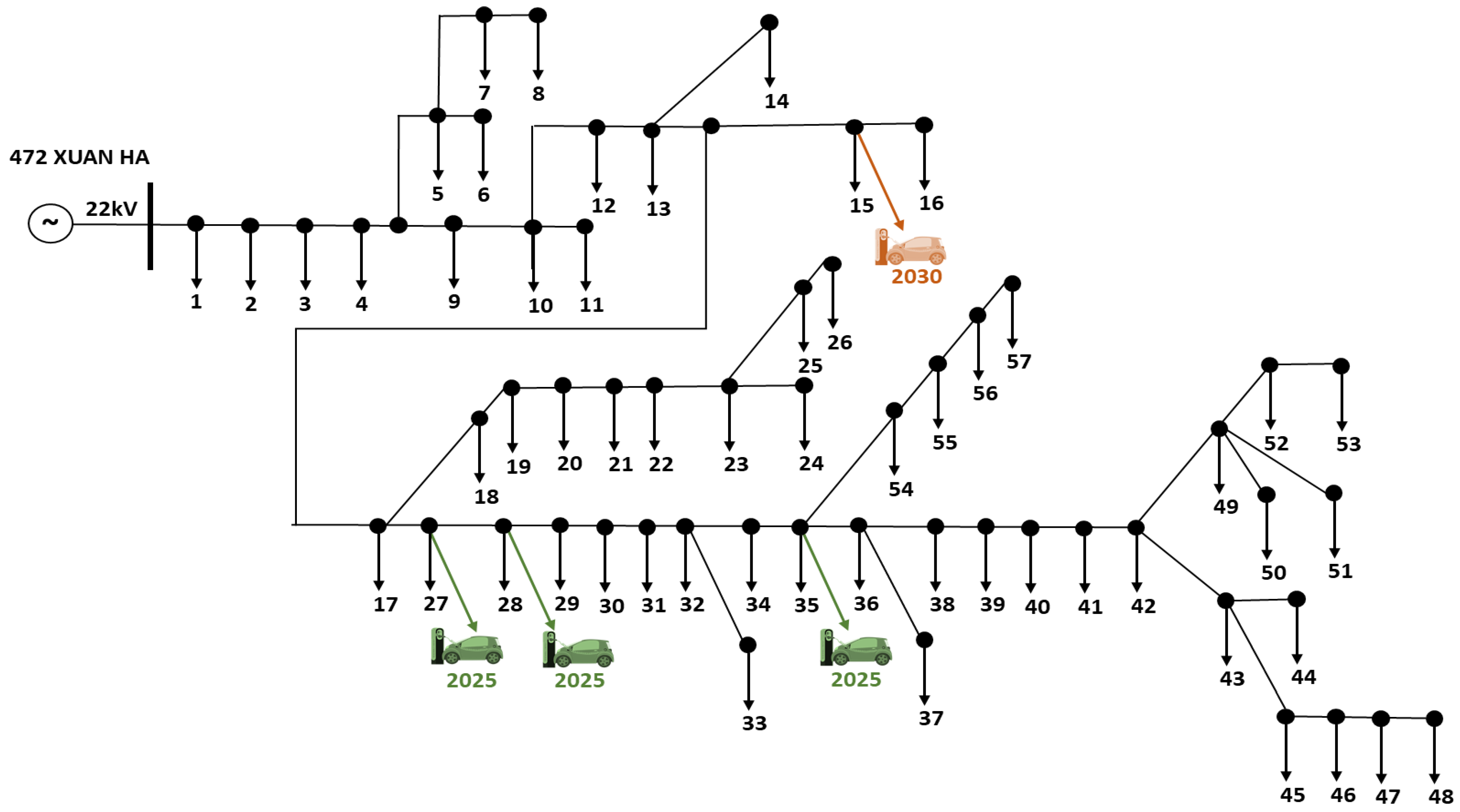
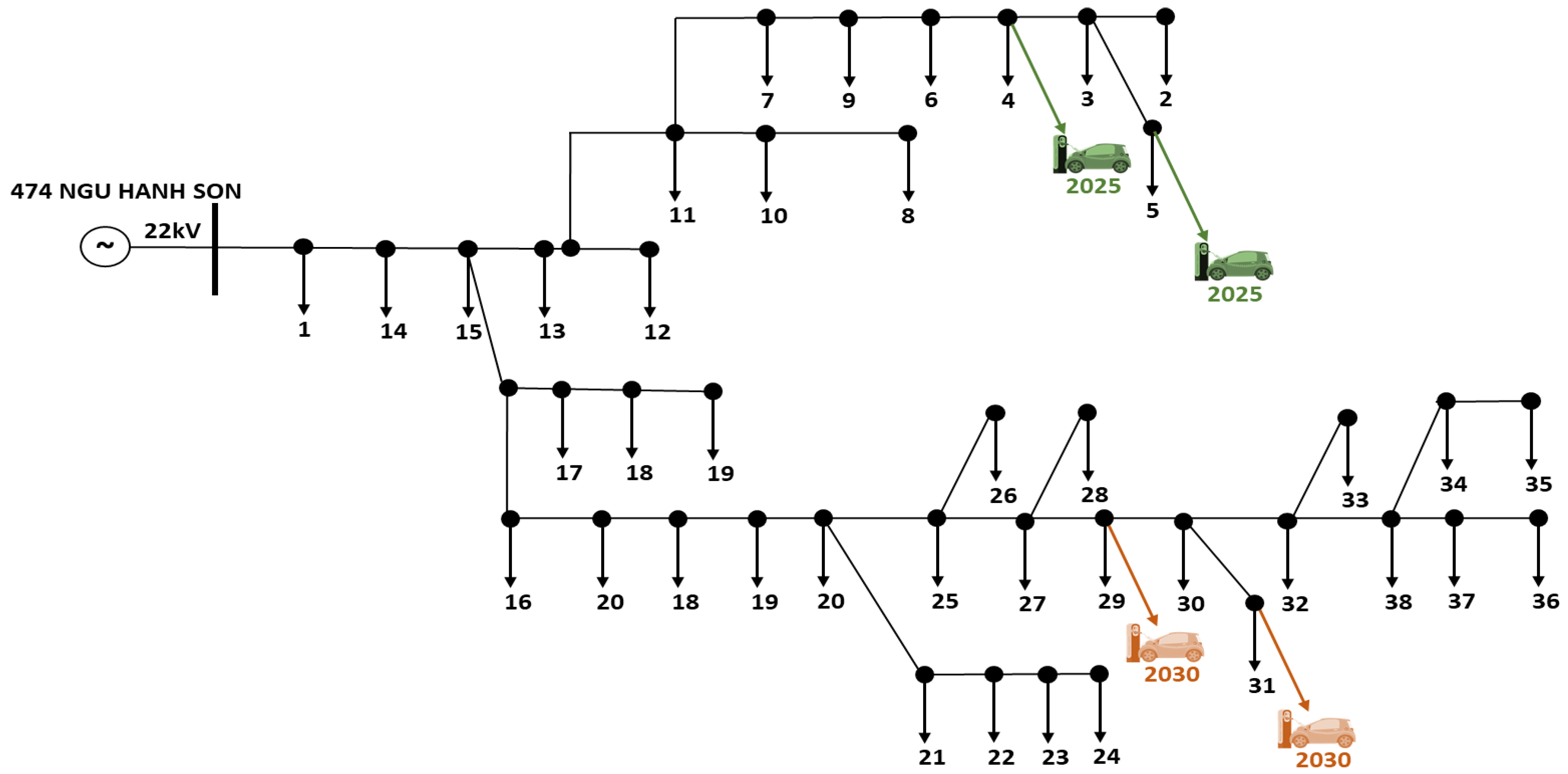
| Parameters | Level 1 | Level 2 | Level 3 |
|---|---|---|---|
| Voltage | 120/230 Vac | 208/430 Vac | 308–600 Vac |
| Current | 12–16 A | 15–80 A | 400 A |
| Power rate | <3 kW | <25.6 kW | >50 kW |
| Charging duration | 17 h | 8 h | <30 min |
| Phase | 1 Phase | 1 Phase/3 Phase | 3 Phase |
| Charger speed | Slow | Fast | Rapid |
| Typical locations | Home | Home, workplace and public | Public |
| Charger Type | Number of Chargers | |
|---|---|---|
| 2020–2025 | 2025–2030 | |
| Charger level 1, 2 | 150 | 250 |
| Charger level 3—Fast charging | 15 | 50 |
| Total | 165 | 300 |
| Requirements | Limits |
|---|---|
| Frequency | 49.8 Hz ≤ f ≤ 50.2 Hz |
| Voltage supply | 20.9 kV ≤ V ≤ 23.1 kV |
| Power losses | ≤10% |
| 472-XHA | 474-NHS |
|---|---|
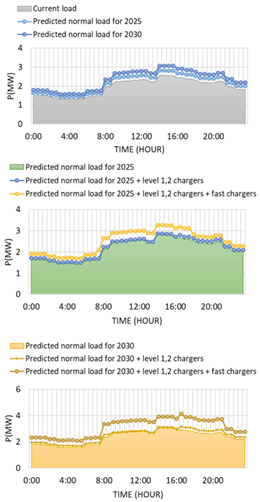 | 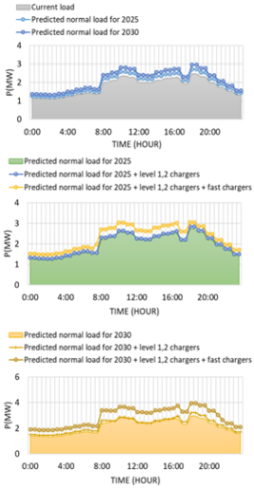 |
| Column | 1 | 2 | 3 | 4 | 5 | 6 | 7 |
|---|---|---|---|---|---|---|---|
| Corresponding scenario | Scenario 1 | Scenario 2.1.1 | Scenario 2.1.2 | Scenario 2.1.3 | Scenario 2.2.1 | Scenario 2.2.2 | Scenario 2.2.3 |
| Considered year | Current | 2025 | 2025 | 2025 | 2030 | 2030 | 2030 |
| Parameters | 1 | 2 | 3 | 4 | 5 | 6 | 7 |
|---|---|---|---|---|---|---|---|
| Current | 2025 | 2030 | |||||
| Integrated Charger level 1 and 2 capacity (kVA) | 0 | 0 | 180 | 180 | 0 | 340 | 340 |
| Integrated Fast charger level 3 capacity (kVA) | 0 | 0 | 0 | 750 | 0 | 0 | 1000 |
| Pmax (MW) | 2.5598 | 2.8161 | 2.9445 | 3.5440 | 3.0720 | 3.3280 | 4.1280 |
| Min_V (kV) | 21.25 | 21.18 | 21.14 | 21.07 | 21.09 | 21.02 | 20.94 |
| ΔV (%) | 3.39 | 3.74 | 3.92 | 4.22 | 4.10 | 4.46 | 4.82 |
| Plosses (MW) | 0.0626 | 0.0763 | 0.0837 | 0.1026 | 0.0915 | 0.1081 | 0.1343 |
| Plosses (%) | 2.39 | 2.64 | 2.77 | 2.81 | 2.89 | 3.15 | 3.16 |
| QLosses (MVAr) | 0.0751 | 0.0916 | 0.1004 | 0.1230 | 0.1097 | 0.1296 | 0.1611 |
| Parameters | 1 | 2 | 3 | 4 | 5 | 6 | 7 |
|---|---|---|---|---|---|---|---|
| Current | 2025 | 2030 | |||||
| Integrated Charger level 1 and 2 capacity (kVA) | 0 | 0 | 160 | 160 | 0 | 330 | 330 |
| Integrated Fast charger level 3 capacity (kVA) | 0 | 0 | 0 | 500 | 0 | 0 | 1000 |
| Pmax (MW) | 2.4301 | 2.6727 | 2.7945 | 3.1945 | 2.9161 | 3.1591 | 3.959 |
| Min_V (kV) | 21.78 | 21.76 | 21.75 | 21.71 | 21.74 | 21.72 | 21.67 |
| ΔV (%) | 0.97 | 1.07 | 1.12 | 1.3 | 1.17 | 1.26 | 1.50 |
| Plosses (MW) | 0.0153 | 0.0185 | 0.0203 | 0.0281 | 0.0221 | 0.0260 | 0.0396 |
| Plosses (%) | 0.62 | 0.6885 | 0.72 | 0.87 | 0.75 | 0.82 | 0.99 |
| QLosses (MVAr) | 0.0183 | 0.0222 | 0.0243 | 0.0336 | 0.0264 | 0.0311 | 0.0474 |
Disclaimer/Publisher’s Note: The statements, opinions and data contained in all publications are solely those of the individual author(s) and contributor(s) and not of MDPI and/or the editor(s). MDPI and/or the editor(s) disclaim responsibility for any injury to people or property resulting from any ideas, methods, instructions or products referred to in the content. |
© 2023 by the authors. Licensee MDPI, Basel, Switzerland. This article is an open access article distributed under the terms and conditions of the Creative Commons Attribution (CC BY) license (https://creativecommons.org/licenses/by/4.0/).
Share and Cite
Nguyen, N.H.; Tran, Q.T.; Nguyen, T.V.; Tran, N.; Roose, L.; Sepasi, S.; Di Silvestre, M.L. A Method for Assessing the Feasibility of Integrating Planned Unidirectional EV Chargers into the Distribution Grid: A Case Study in Danang, Vietnam. Energies 2023, 16, 3741. https://doi.org/10.3390/en16093741
Nguyen NH, Tran QT, Nguyen TV, Tran N, Roose L, Sepasi S, Di Silvestre ML. A Method for Assessing the Feasibility of Integrating Planned Unidirectional EV Chargers into the Distribution Grid: A Case Study in Danang, Vietnam. Energies. 2023; 16(9):3741. https://doi.org/10.3390/en16093741
Chicago/Turabian StyleNguyen, Nam Hoai, Quynh T. Tran, Thao V. Nguyen, Nam Tran, Leon Roose, Saeed Sepasi, and Maria Luisa Di Silvestre. 2023. "A Method for Assessing the Feasibility of Integrating Planned Unidirectional EV Chargers into the Distribution Grid: A Case Study in Danang, Vietnam" Energies 16, no. 9: 3741. https://doi.org/10.3390/en16093741
APA StyleNguyen, N. H., Tran, Q. T., Nguyen, T. V., Tran, N., Roose, L., Sepasi, S., & Di Silvestre, M. L. (2023). A Method for Assessing the Feasibility of Integrating Planned Unidirectional EV Chargers into the Distribution Grid: A Case Study in Danang, Vietnam. Energies, 16(9), 3741. https://doi.org/10.3390/en16093741









